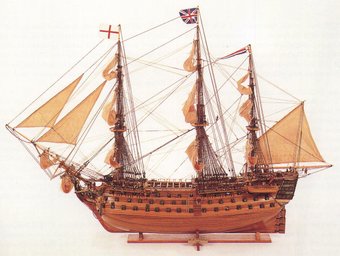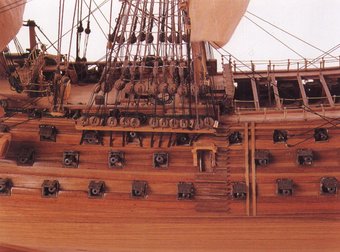HMS Victory
| Size | M | L | Price | ||
| Length | 105 cm | 72 cm | M | € 3.920 - 4.480 | |
| Height | 74 cm | 53 cm | L | € 6.370 - 7.280 | |
| Width | 35 cm | 25 cm | |||
 Geschichte
Geschichte 
- under construction -
Prices
All stated prices are quoted for home delivery. NOT included are local taxes and customs duties. On request we can offer prices for any place in the world!
The exact price for each ship model depends on the transport cost and on the currency exchange rate on the day of purchase. The prices quoted on this website show an approximate price for each model; an exact quotation can be given on request. The experience shows that the exact quoted price is within the given range in 98 % of all inquiries.
Delivery
Each ship model is made by hand with hundreds of man-hours. Depending on the complexity of the ship please allow 4-8 weeks for delivery. Models are shipped safely with specially designed packaging for safe delivery and easy unpacking.
Payment
50 % upon confirmation of order; 50 % on delivery; by SWIFT transfer.
HMS Victory - Detail
 History
History 
The VICTORY was a five-deck, three-masted ship of the line. She was a first-class vessel with three gun decks, 104 cannons and a crew of 850. The ship was designed by Sir Thomas Slade and built between 1759 and May 1765 at Chatham Shipyard. The launching took place on 7th May 1765, after which she layed at anchor in the Medway for thirteen years without being put to any particular use.
In 1795 the VICTORY sailed under the command of Admiral Hotham to the Mediterranean where she served successfully in combat at Cape Vincent. In February 1797, under Admiral John Jervis, she participated in the victorious Battle af Cape Vincent, only to be taken out of service temporarily upon her return to Chatham in November of the same year. In 1801, she went into dock far two years, during which time the vessel was given her present-day appeareance. In 1805 the VICTORY was Captain Nelson's flagship at the Battle of Trafalgar, and under his command she engaged in combat with Admiral Villeneuve's ships, the BUCENTAURE and the REDOUTABLE. This battle decided the fate of Napoleanic Europe.
"At one o'clock in the afternoon the BUCENTAURE sailed into the lee of the VICTORY and presented her stern. As she sailed slowly past, the VICTORY fired the 68 cannons on her fore deck knocking down everybody on deck and in the cabins of the BUCENTAURE and so rendered 300 crewmen unfit for battle. As there was no wind, the BUCENTAURE could not escape and received salvo after salvo from the VICTORY's 50 port broadside". (Barrot de Gaissard "Marine de Guerre à voiles 1750 - 1850").
Although the French defeat was decisive, a seaman firing from the main top of the REDOUTABLE fatally wounded Nelson who had been in command during the battle with Captain Hardy as his righthand man.
 Histoire
Histoire 
Le VICTORY était un trois-mâts, un voilier de ligne de premier rang, doté de cinq ponts, de trois ponts à canons et de 104 canons, ayant à son bord un équipage de 350 hommes. Le vaisseau fut conçu par Sir Thomas Slade et construit de 1759 à mai 1765 dans les chantiers de constructions navales de Chatham. Le lancement eut lieu le 7 mai 1765. Puis le VICTORY resta treize ans amarré sur la rive du Medway, sans mission particulière.
En 1795, le VICTORY se trouvait en Méditerranée avec l'amiral Hotham; il livra un combat au cap Saint-Vincent dont il sortit intact, puis il participa en février 1797, toujours au cap Saint-Vincent, à la bataille que remporta l'amiral John Jervis. Le navire retourna en novembre 1799 à Chatham où il fut retiré du service jusqu'à nouvel ordre. En 1801, on le fit entrer au dock où on lui donna l'aspect qu'il a aujourd'hui. En 1805, dans la bataille de Trafalgar, le VICTORY était le bateau amiral du capitaine Nelson. C'est sous le commandement de ce dernier que le VICTORY rencontra les vaisseaux de l'amiral Villeneuve, le BUCENTAURE et le REDOUTABLE. Cette bataille décida du destin de l'Europe napoléonienne.
"C'est vers une heure de l'après-midi que le BUCENTAURE naviguait sous le vent du VICTORY et lui présenta la poupe. Pendant qu'il passait lentement, le VICTORY fit feu avec 68 pièces d'artillerie de son gaillard d'avant, renversant ainsi tout le monde, sur le pont et dans les cabines, et mettant 300 hommes hors de combat. Aucun vent ne soufflant, le BUCENTAURE ne pauvait s'éloigner et fut obligé d'encaisser les bordées de 50 canons de babord du VICTORY qui firent feu l'un apres l'autre sur la poupe du BUCENTAURE, alors que le vaisseau anglais le dépassait lentement. Les dommages étaient plus impartants que si les Anglais avaient tiré sur la bordée du navire". (Barrot de Gaissard: "Marine de Guerre à voiles de 1750 à 1850").
Alors que la défaite française se dessinait, un marin, du haut de la grand'hune du REDOUTABLE, blessa mortellement Nelson qui commandait la bataille aux côtés du capitaine Hardy.

